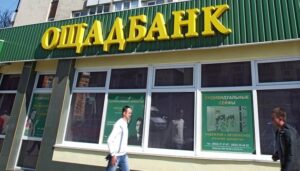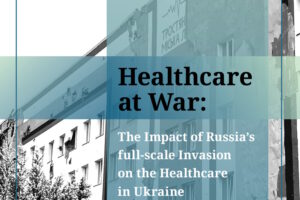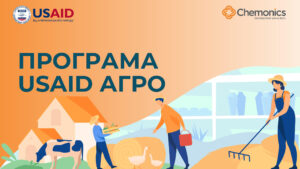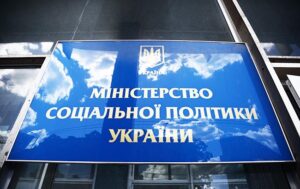
The number of outlets of Ukrainian banks in the first quarter of 2023 decreased by 2.7%, or by 147, to 5.192 thousand, according to the website of the National Bank of Ukraine (NBU).
According to it, in January-March this year, most of all outlets closed Raiffeisen Bank – 27 and A-Bank – 10, then in their networks were 323 and 205 outlets, respectively.
Ukrbudinvestbank reduced the number of outlets by 6 – to 44, Sense Bank and FUIB – by 5, to 138 and 221, respectively, and Ukrsibbank – by 3, to 230.
Among the smaller banks the largest decrease of the network was registered in the bank “Clearing House” – from 5 to 3 branches, Evroprombank – from 6 to 5, and in the bank “Concorde” – from 14 to 12.
Taskombank opened the most number of outlets in the first quarter of this year – 3, increasing their number to 93.
Kredobank and Cominbank added 2 branches to their networks, increasing their number to 67 and 52 correspondingly.
On the whole, the pace of reduction in the number of bank branches in the first quarter of this year slowed down to 2.7%, as in the fourth quarter of the previous year it was 3.3%, in the third – 7.9% and in the second – 8.1%.
This is largely due to the fact that state banks have probably heeded the call of the National Bank, which in February this year suggested that the Finance Ministry, as the owner of state banks, introduce a moratorium on reducing their branch network during the war.
Over the past year, it was reduced in Oshchadbank by 420 business units – to 1.182 thousand, PrivatBank – by 287, to 1.21 thousand, Ukrgazbank – by 51, to 217, and Ukreximbank – by 5, to 48. In the first quarter of this year, Oshchadbank even opened one branch, while PrivatBank closed only one.
According to the NBU, as of April 1 this year in Ukraine, the largest branch networks owned by PrivatBank – 1209, Oschadbank – 1183, Raiffeisen Bank – 323, Ukrsibbank – 230, FUIB – 221, Ukrgasbank – 217, A-Bank – 205, Accordbank – 143, Credit Agricole Bank – 141 and Sense Bank – 138.
State banks at the beginning of April 2023 accounted for 51.2% of all bank branches in Ukraine, which corresponds to the situation before the war, although at the end of last year their share decreased slightly – to 49.8%.
As earlier reported, the number of structural subdivisions of Ukrainian banks in 2022 decreased by 20.2%, or by 1,349 branches, to 5.336 thousand.

Ukraine’s population as of the end of 2022 was about 31.4 million people, of which about 1.15 million live in the temporarily occupied territories, according to experts at the Ukrainian Health Center (UHC).
“The war has resulted in an unprecedented migration crisis and large-scale internal displacements. UCH estimates that at the end of 2022, Ukraine’s population was about 31.4 million people. Of these, 1.15 million people live in the temporarily Russian-occupied territories seized after the start of the invasion,” the center’s report on the health care system after the start of the active invasion states.
The center’s experts also note that in the year after the start of the full-scale invasion, the system of outpatient and specialized medical care has fully recovered, in contrast to the system of primary medical care.
“The consumption of medical services at various levels declined in the first months after the invasion. However, outpatient and specialized medical care gradually recovered to prewar levels during 2022. Primary medical care has not resumed and requires support,” the center’s experts stressed.

Kiev-headquartered investment firm Horizon Capital has raised $254 million in a new Horizon Capital Growth Fund IV (HCGF IV, the “Fund”), exceeding its $250 million target, the company said in a statement Friday evening.
“Today Horizon Capital and our esteemed group of investors made history as the first and largest fund raised since the start of a full-scale invasion,” the statement quoted company founder and CEO Olena Kosharnaya as saying from a private signing ceremony with Ukrainian President Volodymyr Zelensky and international investors from the United States, EU and international institutions.
In January this year, she told Interfax-Ukraine news agency that after raising $125 million in the first round of HCGF IV formation in September last year, it was planned to increase its size to $200 million by the end of March, and tentatively by mid-summer to completely close the formation of the fund in the originally planned amount of $250 million.
As noted in the message of the International Finance Corporation (IFC), which contributed $30 million to the fund at the initial stage of its formation, it has increased its contribution to $60 million, becoming the largest participant in the fund.
“We urge other investors to follow IFC’s lead and not let the newspaper headlines fool you. Financing sectors that others are hesitant to invest in can create tremendous investment opportunities with equally significant potential returns,” Kosharna said.
Among the new investors in HCGF IV, according to releases by Horizon Capital and the European Bank for Reconstruction and Development (EBRD), the Société de Promotion et de Participation pour la Coopération Économique (Proparco), the U.S. International Development Finance Corporation (DFC), Swedfund International AB (Swedfund), the Finnish Industrial Cooperation Fund (Finnfund) and the Danish Investment Fund for Developing Countries (IFU).
“In the context of the war with Ukraine, HCGF IV’s ambitions are unprecedented, and we are encouraged by its fundraising success,” Hassan El Khatib, managing director of equities, said in an EBRD release.
In addition to the EBRD, which contributed $40 million to HCGF IV in the first phase, its investors also included Deutsche Investitions-und Entwicklungsgesellschaft (DEG) and its subsidiary KfW Group, the Dutch Enterprise Development Bank (FMO), the Swiss Investment Fund for Emerging Markets (SIFEM) ), Western NIS Enterprise Fund and Zero Gap Fund, formed in collaboration between The Rockefeller Foundation and John D. and Catherine T MacArthur Foundation.
“The fact of exceeding the original ambitious goal of $250 million demonstrates a high level of investor interest in attractive opportunities in high-growth, high-impact technology and export-oriented companies, including those in the light and food processing, innovative consumer products, fintech, etc. sectors,” noted Horizon Capital.
It is also noted that HCGF IV was the first fund in Central and Eastern Europe (CEE) and one of about ten funds in the world to achieve 2X Flagship Fund status, including one of only two that are founded and led by women. The 2X Challenge was launched at the 2018 G7 Summit as a bold commitment by companies to invest in women in the world and promote gender equality in finance.
IFC specified that the fund would invest $10-30 million to acquire minority stakes in 10-15 mid-cap and $50-150 million companies in Ukraine and Moldova. HCGF IV is the $200 million successor to EEGF III, which was completed in 2017, and will follow a similar investment strategy focused on IT services and products as well as e-commerce, innovative consumer products and fintech, according to corporate materials.
IFC recalls having invested in EEGF III and EEGF II (2008), while EBRD was an investor in EEGF III and EEGF II as well as HCGF II.
Horizon Capital is a large investment company managing 6 private equity funds (more than 40 institutional investors) with assets of $1.4 billion, among which are WNISEF ($150 million), Emerging Europe Growth Fund (EEGF, $132 million), EEGF II ($370 million) and EEGF III ($200 million), as well as HCGF II ($258.3 million). The funds of these funds were invested in more than 160 companies, which employed more than 77 thousand people, in Ukraine and Moldova.

The USAID Agro program has more than doubled grant co-financing for elevator capacity expansion projects, increasing it from UAH 185 million to UAH 380 million, which should allow for 20 projects, the program’s press service said Thursday.
“The USAID AGRO program increases … the number of potential co-financing projects from 10 to 20 to expand grain storage and drying facilities. This will allow participants in the grain market to compensate for the lack of capacity arising in Ukraine due to limited exports and complicated logistics,” the donor organization said.
It is assumed that the funds will be used to purchase equipment for the processing, drying and storage of grain, as well as the purchase of laboratory equipment to determine the quality of grain.
Applications for the third stage of the contest will be accepted until June 12, 2023 at 18:00 o’clock or until the money has been exhausted.

The average number of children deprived of parental care has not changed significantly during the full-scale war, the Minister of Social Policy of Ukraine Oksana Zholnovych said.
“In general last year, according to the statistics that we received, the average number of children who are removed has not changed much, it is approximately the same format as every year. It’s about 8,000 to 9,000 children a year,” Zholnovich said on national telethon Tuesday.
The Minister noted that, as a significant number of families with children have gone abroad, identification of difficult life circumstances for them is carried out outside Ukraine, and the Ministry of Social Policy only accompanies this process.
As for the deprivation of parental care, which is associated with new challenges because of the war, there are about 500 such cases today, according to Zholnovych.

Medical network “Dobrobut” has purchased the capital’s digital dentistry clinic TEFI (both in Kiev), which will become part of Dobrobut Dental Clinic.
According to the network’s press release, the founder of the TEFI clinic, Marina Bilous, plans to set up a modern dental clinic in London.
“I am glad that I am putting my clinic in the hands of reliable partners. It is very important to me that clients, who are used to high quality services and careful attitude to themselves, do not feel any changes, except for a change for the better. I am sure that Dobrobut will preserve and develop all the achievements, which our team is sincerely proud of,” Bilous was quoted in the press release.
According to Vadim Shekman, general director of Dobrobut, the chain is investing in various medical areas, particularly in the development of dentistry.
“The acquisition of the TEFI clinic is another step in this direction. TEFI’s high standards and personalized approach to each client will now unite under the Dobrobut Dental Clinic brand with Dobrobut’s multidisciplinary approach and become part of our medical ecosystem,” he said.
The clinic’s new 346-square-meter dental department has five treatment rooms equipped with state-of-the-art equipment, including an Orthophos SL dental tomograph and a digital radiovisiography unit (Dentsply Sirona). The surgical unit is equipped with an operating room for surgical interventions and treatment under anesthesia.
The new Dobrobut Dental Clinic department will offer all dental services, including aesthetic prosthetics, implants, and orthodontic treatment for children and adults.
“Dobrobut is one of the largest private medical networks in Ukraine. The network consists of 17 medical centers in Kiev and Kiev region, emergency service, dentistry and pharmacies. Network medical centers provide services to children and adults in more than 75 medical fields. Annually experts of “Dobrobut” carry out more than 7 thousand operations. The network has over 2,800 employees.
Dobrobut cooperates with a number of international charitable organizations such as Direct Relief International, Children of War Foundation, International Medical Corps and the University of Miami Global Institute, as well as with the Dobrobut Charitable Foundation founded by the hospital.
“Dobrobut became the first private network in Ukraine to receive funding from the U.S. federal government – with the support of the U.S. International Development Finance Corporation (DFC), the company will build a state-of-the-art physical rehabilitation center.